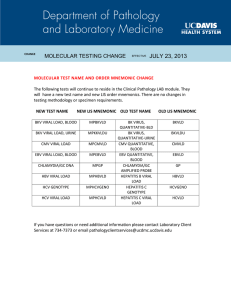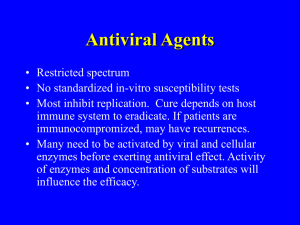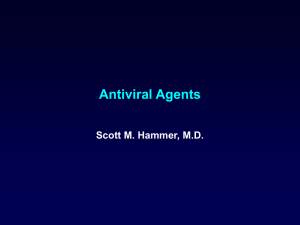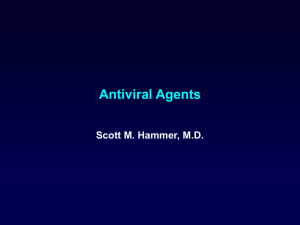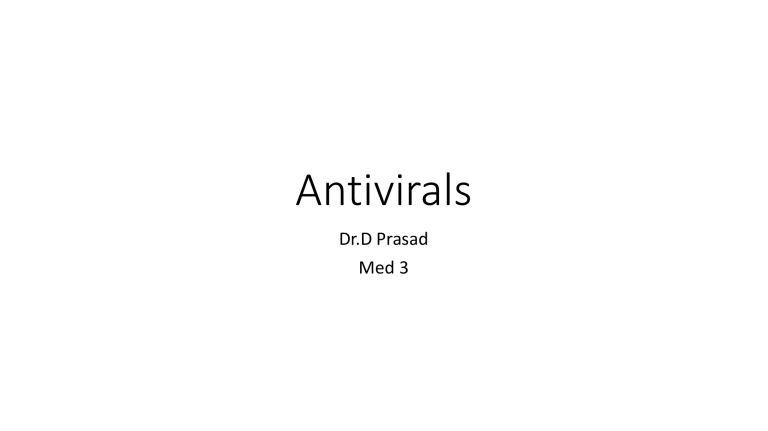
Antivirals Dr.D Prasad Med 3 FO2.41: Understand the principles of therapeutics with medications for viral infections. Given a clinical or experimental scenario, image, table, or graph, the student should be able to: FO2.41.1. Describe the classification and general mechanisms of action of antiviral agents based on the stages of viral replication that are targeted FO2.41.2. Recognize the mechanisms of action, therapeutic uses, adverse effects, and mechanisms of resistance of drugs for herpes simplex virus, varicella, and cytomegalovirus infections Herpes simplex virus (HSV) & Varicella-zoster virus (VZV) infections • Acyclovir • Valacyclovir • Famciclovir • Penciclovir • Docosanol • Trifluridine ACYCLOVIR • Acyclic guanosine derivative • Active against HSV-1, HSV-2, and VZV Mechanism: Resistance: • Reduced or absent thymidine kinase • Altered viral DNA polymerase Adverse effects : • Acute renal failure • Neurologic VALACYCLOVIR • L-valyl ester of acyclovir. • Converted to acyclovir FAMCICLOVIR • Converted to penciclovir. • Penciclovir does not cause chain termination. PENCICLOVIR • Active metabolite of famciclovir • Topical use. DOCOSANOL • Inhibits fusion between the host cell plasma membrane and the HSV envelope • Prevents viral entry into cells TRIFLURIDINE • Phosphorylated intracellularly by host cell enzymes • Competes with thymidine triphosphate for incorporation by the viral DNA polymerase • Effective in treating keratoconjunctivitis and recurrent epithelial keratitis Agents to treat Cytomegalovirus (CMV) infections • Ganciclovir • Valganciclovir • Foscarnet • Cidofovir. GANCICLOVIR • Acyclic guanosine analog Mechanism: • Initial phosphorylation is catalyzed by the virus-specified protein kinase phosphotransferase UL97 • Activation by triphosphorylation • The activated compound competitively inhibits viral DNA polymerase and causes termination of viral DNA elongation Resistance: • Mutation in UL97 Uses: CMV Retinitis CMV colitis, esophagitis, and pneumonitis Adverse effect: • Myelosuppression VALGANCICLOVIR • prodrug of ganciclovir FOSCARNET • inorganic pyrophosphate analog Mechanism: • inhibits herpesvirus DNA polymerase, RNA polymerase directly • blocks the pyrophosphate binding site of these enzymes and inhibits cleavage of pyrophosphate from deoxynucleotide triphosphates Uses: End-organ CMV disease (ie, retinitis, colitis, and esophagitis), including ganciclovir-resistant disease Ganciclovir + Foscarnet is synergistic against CMV retinitis Acyclovir-resistant HSV and VZV infections. Adverse effects • Renal impairment • Genital ulcers • hypocalcemia • hypo- or hyperphosphatemia • Hypokalemia • hypomagnesemia CIDOFOVIR • cytosine nucleotide analog Mechanism: • Phosphorylation of cidofovir to the active diphosphate is independent of viral enzymes Adverse effect: • Nephrotoxic • administered with high-dose probenecid which blocks active tubular secretion and decreases nephrotoxicity. • aggressive adjunctive hydration is required Hepatitis B (HBV) virus infection • Pegylated interferon (PEG-IFN) • Entecavir • Tenofovir dipovoxil fumarate • Adefovir • Lamivudine Hepatitis C (HCV) Infection • Ribavirin • Interferons • Ledipasvir • Simeprevir • Sofosbuvir Anti - Influenza Agents • Oseltamivir • Zanamivir • Amantadine • Rimantadine Antiretroviral agents • Nucleoside & Nucleotide Reverse Transcriptase Inhibitors (NRTIs) • Nonnucleoside Reverse Transcriptase Inhibitors (NNRTIs) • Protease Inhibitors • Entry Inhibitors • Integrase Strand Transfer Inhibitors Acyclovir Famciclovir Valacyclovir Ganciclovir Valganciclovir •Guanosine analogs and inhibits viral DNA polymerase •Specifically processed by HSV/VZV enzymes •Guanosine analogs and inhibits viral DNA polymerase •Specifically processed by CMV viral enzymes •HSV •VZV •Bone marrow suppression •CMV •Viral DNA and RNA polymerase inhibitor •Ganciclovir-resistant CMV Foscarnet Cidofovir •Viral DNA polymerase inhibitor •Obstructive crystalline nephropathy which can lead to acute renal failure •hydration can prevent this •Renal toxicity •Electrolyte abnormalities •CMV retinitis •Renal toxicity •Acyclovir-resistant HSV •Coadminister with probenecid and hydration
